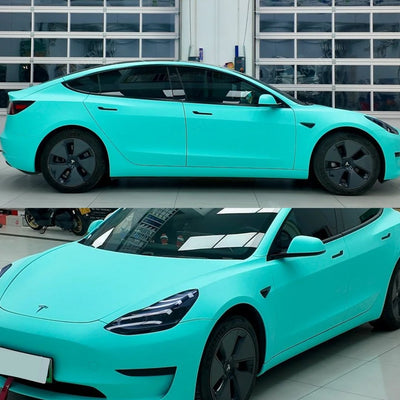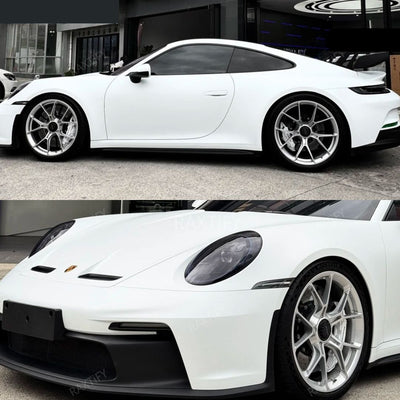
Can You Vinyl Wrap Over Bare Metal?
No, you cannot wrap vinyl directly over bare metal without first smoothing, priming the surface, and repairing any rusted areas. Vinyl wrap is renowned for its ability to easily and effectively enhance the appearance of cars. For optimal and long-lasting performance, the surface must be completely smooth, clean, dry, and free of imperfections. In this blog, we will discuss whether you can wrap vinyl over bare metal, and provide tips, techniques, and potential challenges involved in doing so.
Why It's Not Recommended to Wrap Vinyl Over Bare Metal?
While technically possible, several issues can arise that compromise the durability and appearance of the wrap:
1. Rust Development
Bare metal is prone to rust, especially in moist conditions. Vinyl wrapping can trap moisture against the metal, accelerating rust formation underneath the wrap.
2. Surface Imperfections
Bare metal surfaces, even when sanded, often have imperfections like bumps or scratches. These imperfections can show through the vinyl wrap, affecting its aesthetic appeal and longevity.
3. Heat Damage
Bare metal conducts heat more effectively than painted surfaces. This can cause the vinyl to warp or develop bubbles when exposed to high temperatures, which compromises its integrity over time.
4. Shortened Lifespan
Proper surface preparation, including priming, is crucial for the longevity of a vinyl wrap. Applying vinyl directly to bare metal without priming increases the risk of premature deterioration and failure, leading to potential costly repairs.
How to Prepare Bare Metal for Vinyl Wrapping
Applying vinyl directly to bare metal car parts can be challenging, but with proper preparation, it can be done effectively. Follow these steps:
1. Thoroughly Clean the Surface
Start by cleaning the bare metal surface thoroughly to remove dirt, grease, wax, or any contaminants. Use a mild detergent or specialized surface cleaner, along with clean water and a microfiber cloth or sponge. Ensure the surface is completely dry before proceeding.
2. Sand the Bare Metal Surface to Smoothness
Inspect the surface for imperfections such as scratches, dents, or rust spots. Smooth out these imperfections by sanding the surface with sandpaper, focusing on rough areas to eliminate rust and achieve an even texture.
3. Prime the Surface for Strong Adhesion
Apply a high-quality primer specifically designed for bare metal surfaces. The primer promotes adhesion, prevents corrosion, and provides a smooth base for the vinyl wrap to adhere to. Ensure the primer is compatible with both the bare metal and the vinyl adhesive for optimal results.
4. Apply Heat to Remove Moisture
Use a heat gun or other heat source to gently warm the bare metal surface before applying the vinyl wrap. This step helps remove any remaining moisture, enhances the vinyl's conformability, and improves adhesion. Allow the metal surface to cool completely before proceeding with the vinyl application.
5. Conduct Test Adhesion
Before applying the vinyl wrap to the entire surface, perform a test adhesion by applying a small piece of vinyl to a discrete area. Press the vinyl firmly and check for any signs of lifting or poor adhesion. If the test piece adheres well, proceed with wrapping the entire surface.
6. Apply Vinyl Wrap to Prepared Surface
Once the bare metal surface is properly cleaned, sanded, primed, and tested, carefully apply the vinyl wrap according to the manufacturer's instructions. Use a squeegee to smooth out the vinyl, working from the center outward to minimize air bubbles and ensure proper adhesion.
Other Surfaces You Cannot Wrap Vinyl Over
While car wraps are a great way to enhance your vehicle's appearance, certain surfaces require preparation before applying vinyl. These include:
-
Damaged Paint: Vinyl wraps adhere best to smooth, undamaged paint. Wrapping over damaged areas can exacerbate the issue and make imperfections more noticeable. Even if the wrap initially sticks, removing it may damage surrounding paint.
-
Deep Scratches: Deep scratches will remain visible under the wrap and may worsen during installation or removal. While some wraps can minimize their appearance, they are not a permanent solution over damaged surfaces.
-
Orange Peel Texture: This rough texture, caused by a poor paint job, will show through the vinyl wrap. Prioritize professional paint correction before considering a wrap. Even after correction, the condition of the paint upon removal of the wrap remains uncertain.
-
Rusted Metal: Vinyl adhesive cannot bond effectively to rusted surfaces. Rust weakens the bond and can cause the wrap to peel. Address rust issues professionally before considering vinyl wrapping.
-
Peeling Clear Coat: If a vinyl wrap is necessary, consider having chipped or peeling areas professionally sanded or "feathered" to create a smoother surface. Glossy or chameleon wraps should be avoided as they can highlight imperfections. Use wraps cautiously as a last resort to achieve desired results.
Conclusion - Do Not Wrap Over Bare Metal!
While it may seem tempting to save time, taking shortcuts like wrapping over bare metal can lead to costly consequences. Proper surface preparation is paramount for achieving a flawless and durable vinyl wrap job.
By following best practices and treating bare metal before wrapping, you ensure the longevity and quality of your vinyl-wrapped surface. This approach not only saves time and money in the long run but also enhances the overall finish.
It's also crucial not to compromise on the quality of the vinyl itself. For premium-grade wraps, consider exploring RAXTiFY's catalog for reliable options. This ensures you get the best results for your vehicle customization needs.































